Text
Top 10 Best Wine Apps for 2019
Mobile apps exist to make your life easier and better. When it comes to wine, this can mean a few different things: learn more about wine, helping you chose better wine, record your tasting experiences, get a better deal/price for your plonk, find expert ratings, or pick the best vintage. Also, and it's not the […]
The post Top 10 Best Wine Apps for 2019 was written by Julien Miquel and appeared first on Social Vignerons.
0 notes
Text
Tasting the finest wines of València & Spain's Levant

This past New Year's Eve found me in València, hired on as the “wine expert” for a group that had flown down for the UK to say goodbye to 2018 and take on the mantle... more>
0 notes
Text
Play outdoors in magical Family Adventure Garden at San Antonio Botanical Garden
I've visited a lot of play gardens, and I play in ALL of them. But one of the most exciting I've seen opened this spring at San Antonio Botanical Garden. The Family Adventure Garden at SABG offers the delights of nature exploration that children instinctively love, and that I and so many of my peers grew up with in the era of free-range childhood, before electronic devices, stranger-danger, and the stresses of overworked parents and overscheduled kids conspired to keep children indoors or on soccer fields. A single entrance and exit helps keep younger children corralled, but never fear, kids - the garden feels huge and unconstrained. A striking rusty-steel arch with rebar crisscrossing along the top gives vines a way to climb and provides shade. A fountain patio beckons just inside the gate, anchored by an elevated steel sluice and circular basin. The Watering Hole, as this space is called, represents part of the history of Texas, with its fountain carrying recycled water via elevated acequia (a community-operated watercourse) to a holding tank. I imagine this is a cool spot for parents to hang out on a hot day while their kids play nearby on a grassy slope called […]
The post Play outdoors in magical Family Adventure Garden at San Antonio Botanical Garden appeared first on Digging.
0 notes
Text
How to Open a Bottle of Wine Without Opener?
Uncorking a bottle of wine without a corkscrew, using just a shoe, is a bit of a myth in the wine community. Not that many of us have actually tried it. So, does it actually work in real life? It all starts with a moment of anxiety. You're with that special friend(s) you have this […]
The post How to Open a Bottle of Wine Without Opener? was written by Julien Miquel and appeared first on Social Vignerons.
0 notes
Text
A close encounter with Devils Tower in Wyoming
The ultimate destination on our mother-daughter road trip through the Great American West last month was Devils Tower National Monument in northeastern Wyoming. (Yes, the lack of apostrophe is the correct geographic spelling.) I've wanted to see it for years, ever since it appeared as a hub for UFO meetups in Close Encounters of the Third Kind. As a child I could hardly believe such a weird-looking formation actually existed. Devils Tower stands high above the Black Hills prairie like a gigantic tree stump. You won't happen upon it while heading somewhere else. Like Big Bend National Park in West Texas, its remoteness from cities means you have to mean to see it. That makes getting there even more special. We arrived near sunset on August 9, just missing the Devils Tower congregation of thousands of bikers during the Sturgis Motorcycle Rally. On that mellow late afternoon, we had it nearly to ourselves, just us and a few bison in a field outside the park. How iconic is this scene? Bison, prairie, and Devils Tower. For good measure, a longhorn made an appearance too. The next morning we got up before sunrise to visit Devils Tower again for an early […]
The post A close encounter with Devils Tower in Wyoming appeared first on Digging.
0 notes
Text
A taste from the east, Crama Ferdi
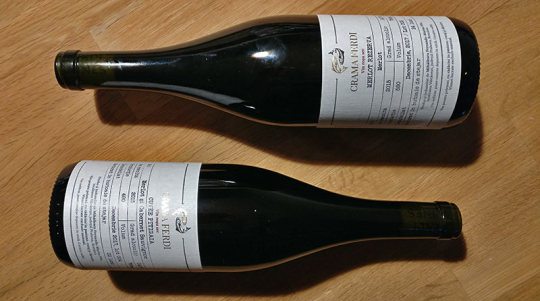
One judges wine competitions neither for fame nor money which is good as both are in staggeringly short supply for the activity. So, why do it? Well, to challenge yourself into being more analytical about... more>
0 notes
Text
Pampering Peppermint Coconut Foot Scrub
What do achy, dry, rough feet need? A little pampering straight from the garden! That's right, even your feet benefit from a little garden therapy. This peppermint foot scrub is made specifically for feet. Exfoliating sugar and dried herbs will scrub away rough skin, coconut oil will soften cracks, and soothing peppermint essential oil has a cooling ... Read More about Pampering Peppermint Coconut Foot Scrub
The post Pampering Peppermint Coconut Foot Scrub appeared first on Garden Therapy.
0 notes
Text
Frond, a shop for houseplant lovers
Chalk it up to my weird indifference to houseplants, but it's taken me two years to check out Frond Plant Shop on West Mary Street, right off South 1st, even though I kept hearing good things about it. Make that former indifference! Frond has unlocked my latent fondness for houseplants, in no small part because of the store's appealing styling, with an emphasis on pairing plants with beautiful pots and baskets in muted colors and natural textures. It's very touchable here. My fingers lingered over creamy woven baskets with tassels, smooth wooden pots, nubby seagrass baskets, and matte black and white ceramic pots, with an interesting variety of small to medium-size plants artfully displayed on tables and shelves. Diamond shelving is on point. Even the art on the wall is of houseplants. I really liked the small African-style baskets on the third shelf. The owner is a young woman named Sara, and these are, I believe, her sketches taped to the wall behind the counter. Her father is a painter, and several of his botanical still-lifes are for sale. This one seriously tempted me. Sara was friendly and helpful when I asked for her assistance in choosing a couple of […]
The post Frond, a shop for houseplant lovers appeared first on Digging.
0 notes
Text
Classic Western Burgers + Zinfandel
Recipe and Tips for a Classic American Wine & Food Pairing At your next summer barbecue, try adding wine to ground beef for juicy, flavorful classic western burgers. Sweet, ripe zinfandel wine pairs well with all the spicy and tangy condiments you can add to these burgers, such as grilled onions and crispy bacon. The […]
The post Classic Western Burgers + Zinfandel was written by Julien Miquel and appeared first on Social Vignerons.
0 notes
Text
Bringing the “stonk”, Halls Gap – Fallen Giants 2014
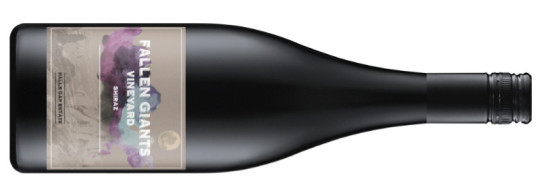
I'm often at a loss for words–at least in other languages. In English, I'm generally well set (sorta) but every so often, a word pops up in British English that we sorely need in American English. While some of my fellow countrymen have adopted “spot on” as of late, it sounds horridly wrong with an American accent, double so if said by anyone who talks with “upspeak“. But then there's the British word, stonkin' which in essence means that something is very good or impressive.
This is a great word and I'm really pissed about it as it should have been an American word. “How's the barbecue going Jim?” “Stonkin'!” Well now that I think about it, it should have been an Australian word as honestly, I can think of no better word than stonkin' to sum up the Halls Gap “Fallen Giants” Shiraz that I recently tried.
The vineyard for this wine is in the Grampians GI which for some reason, with some sellers gets lumped in with Mornington Peninsula despite the fact they're 250km apart. They're still both in the state of Victoria albeit Mornington, now known for its stellar Pinot Noir and Chardonnay is just a stone's throw from Melbourne whilst Grampians you could only reach by stone if you were to carry that stone on a nearly three hour drive in the car, which Australians I've met talk about as if it were a quick jaunt to get milk.
Grampians is getting rightly known for its Syrahs. There's also a good helping of Cabernet Sauvignon, Merlot, and Pinot Noir as it has a cooler climate pitched up against the Grampians Mountains. If this wine is any indication however, they should just circle their wagons around the Syrah grape because yes, it is definitely more Syrah than Shiraz or perhaps “Syhraz”.
It's a wine that has all that great ripeness and cleanliness find throughout a wealth of Australian wine but it's so much more than that or, “moreish” to borrow another amazing word from British vernacular. There's depth and complexity, length and polish, and well, balance for lack of another overused word. I just wanted to spend an hour smelling it but it was such a tasty, delicious wine, it was hard to stop from polishing it off. I highly recommend checking it out if you've not had the chance.
Fallen Giants Shiraz 2014
Deep, dark ruby red. No rim, no nothing. Dark cherry, blackberry compote, eucalyptus, herbal garrigue and sage. Earthy notes on the palate, more red fruit comes through. Quite rich, medium plus acidity and finish. Seems like a big, pointy Shiraz but is incredibly well articulated with a lot of style and subtlety.
100% Syrah 14% 25€
** 93
0 notes
Text
The Incredible Primroses of Yunnan and Western China

Am I an adventure junkie? Not exactly, but I do like travel, different cultures, world travel as well as plants and most of nature (except snakes), so any opportunity to geek out with some friends on a single genus is an opportunity I am going to jump at. In this part of northwestern Yunnan there are a number of plants one could possibly geek-out on like rhododendrons, corydalis, lilies or wild orchids, but really it's the primroses that brought me here.
Half of the world's wild primroses come from the vast landscape of the Himalayas, with 500 species worldwide, at least 300 of them are found in this mountain range and over a hundred in Yunnan. Since primulaceae is one of my most favorite plant families, I wanted to dedicate a single post to just primula that we saw on this trek, so here you go. Fair warning though - the names are still being worked out, I only have a couple of good books to key out what we found, so if you're an expert, feel free to correct me and I'll credit you. Aside from that, enjoy the shots!

The tiny and lovely mat-forming Primula nanobella, here on the top of Shikashan, elevation 14,000. We saw this on the high mountain tundra found on many mountains from Shangrila, going northwest to the Tibetan border. Growing no higher than 3 inches in some places it virtually covered the ground. The tube or 'mouth' is filled with fibers or a pom pom of tiny lavender hairs which make the center of the flower appear blurry or congested, an interesting feature that liked to freak out my camera as it focused.

The singular flowers of P. nanobella arise from the tiniest rosettes, no larger than a thumbnail, and as you can see, their color was practically a florescent violet.

I shot lots of videos as well, which I hope to edit into some project in the future, or just to show at future talks, but this tiny primrose was very animated as the wiry stems ensured that the flowers would bounce and wave in the strong winds.

Primula dradifolia, Baimashan
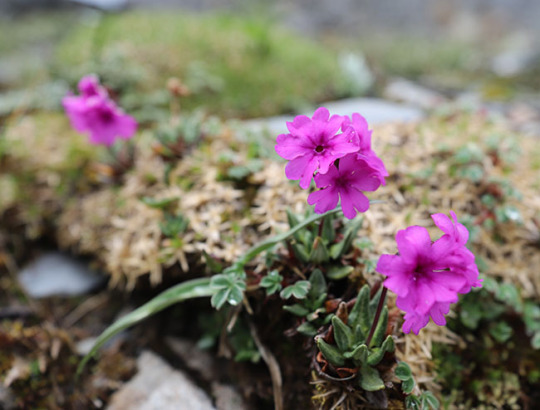
Another view of what I believe is P. dryadifolia. I just can't find a good image in any of my books.

Here is a view of our group botanizing in an open alpine meadow on Shikashan (or Shika Shan, as 'Shika' means deer, and 'Shan' means mountain). This meadow was full of primroses and that low shrub you see blooming is rhododendron.
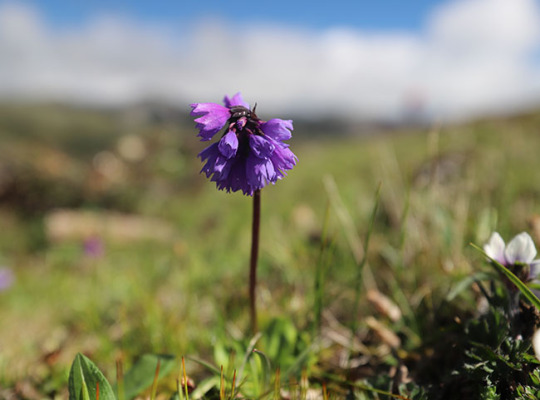
PRimroses in the section Muscarioides look somewhat like the Dutch bulb Muscari.
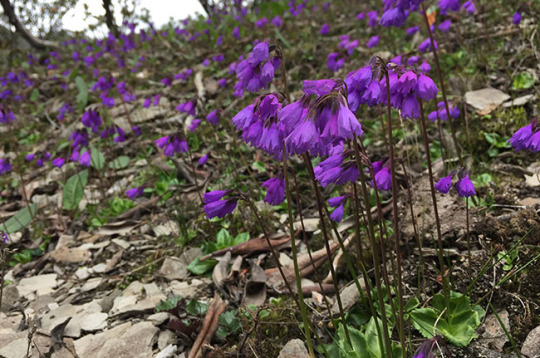
Primula amethystina subsp. brevifolia on Shika Shan, Yunnan, China.

Perhaps Primula pinnatifida(?), on Baimashan, 14,000'.
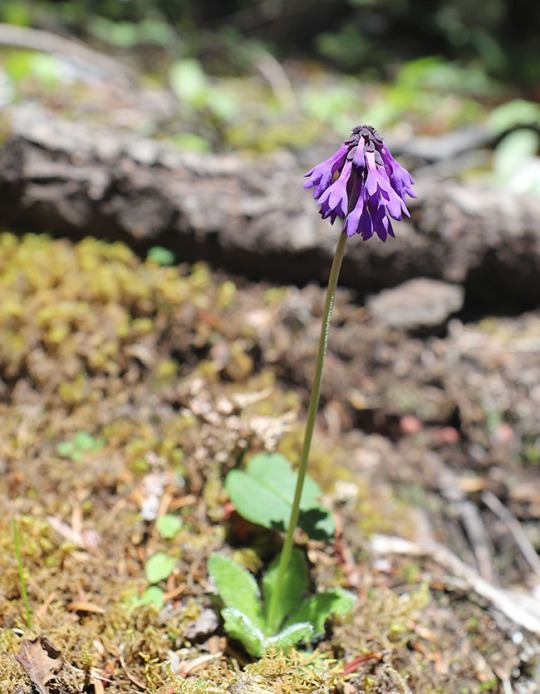
At lower elevation this may be the same species but at 12,000' more elongated.
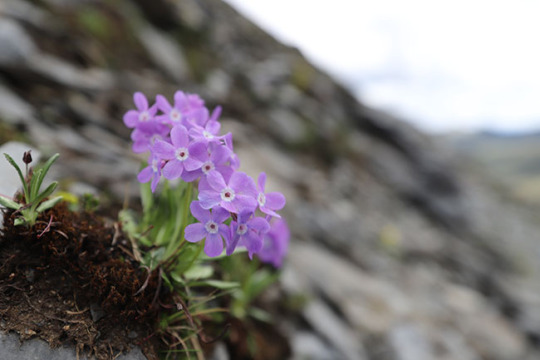
Primula minor, on a pass, Hong Shan, 4500m. Don't tell me that it's P. brevicula, but...ok, if it is, let me know. I don't have a good key aside from the fine new book Flowers of Western China by Cribb and Grey-Wilson (Kew).
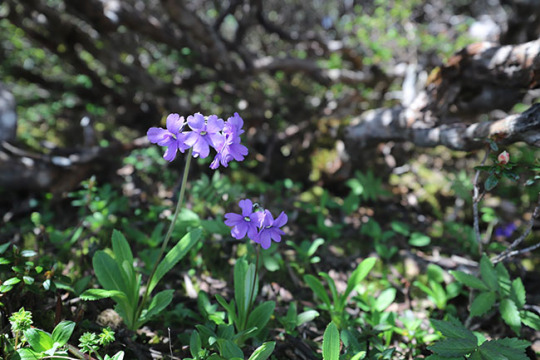
One of the mystery primroses. Please share your ID notes if you think that you know which one this is. Shika Shan, NW. Yunnan around 12,000'.

P, chionantha subsp. sinopurpurea
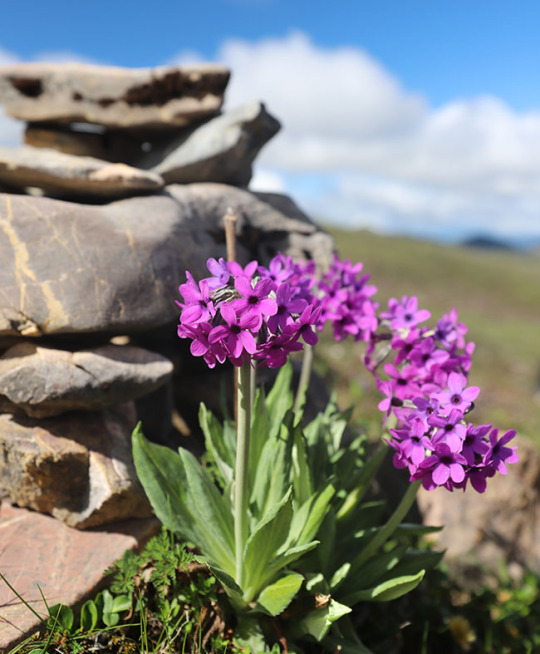
More Primula chionantha subsp. sinopurpurea but shorter, as this is at high elevation on the summit of ShikaShan, 4400m.

Getting familiar with a nice specimen of Primula chionantha subsp. sinopurpurea. I know - I look bulked up -No fat shaming allowed, I just should have removed the two sweat shirts I had on under my rain gear -- it was cold!
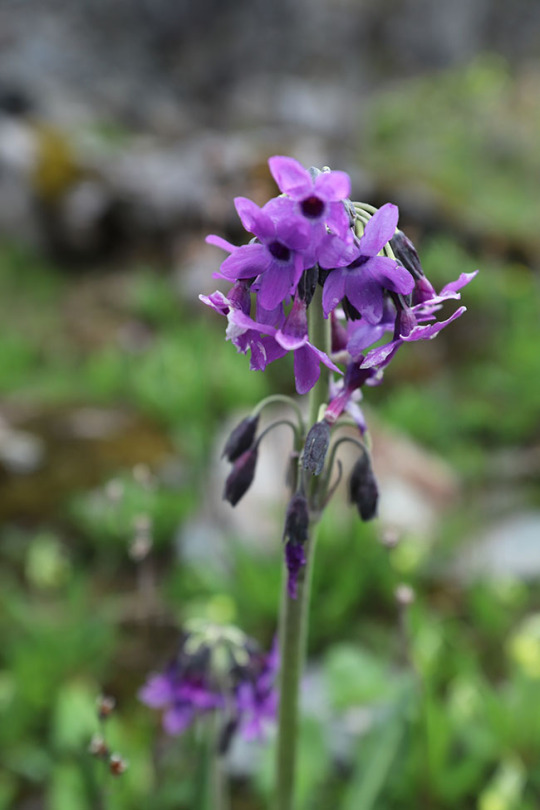
P, chionantha subsp. sinopurpurea on the mining road leading up to Hong Shan.
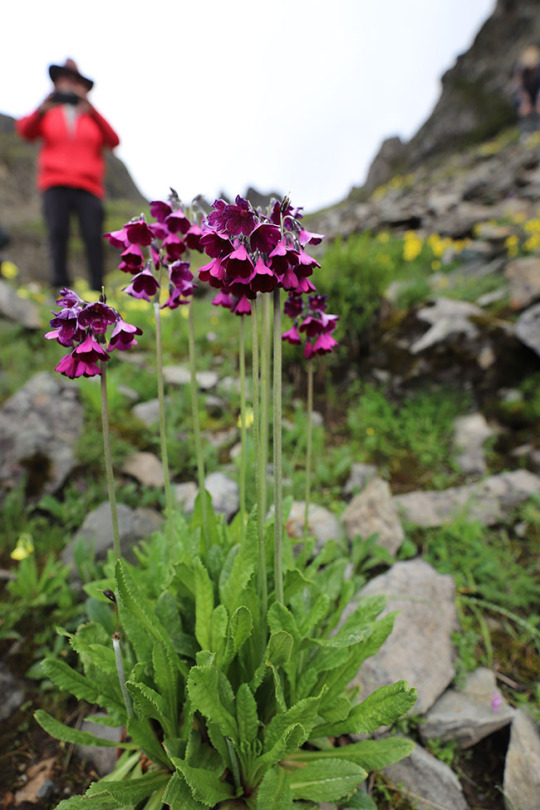
Primula secundiflora, near the pass at Hong Shan, 4500 m.

Primula yunnanensis, Baimashan, NW Yunnan
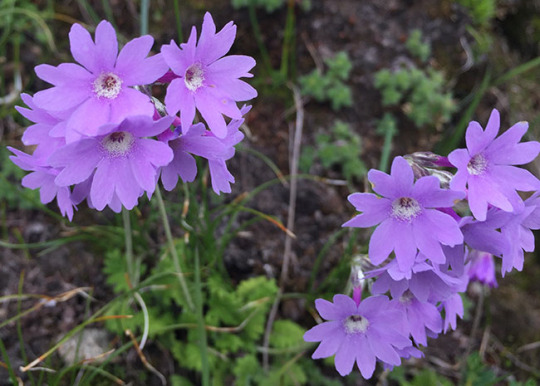
A closer view of P/. yunnanensis. See the tiny bits of white farina?

My eyes are getting tired, but I cannot seem to ID this one...any ideas?

P. sikkimensis , perhaps var.pseudosikkimensus however, this was at high elevation on Shikashan at 14,000' and not on Yulongxueshan in NW Yunnan where the variant is presumably limited to at high elevation. The large blossoms and short stature at high elevation make it difficult to ID. I welcome thoughts from the primula experts.

Of all the primula species it is this beauty, the fragrant (as Panayoti Kelaidis From the Denver Botanic Garden demonstrates here) Primula sikkimensis that really puts on a show as it often forms great colonies both at high elevation and above 9,000' throughout this part of the Himalaya. We found spectacular colonies near streams and seeps throughout our trek.

At high elevation, such as this stream bed on Hongshan near 15,000' the colonies stopped us in our tracks.
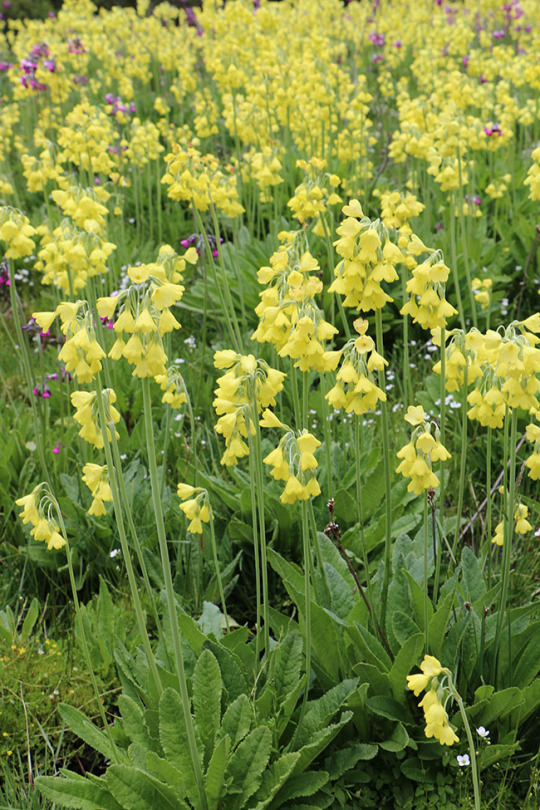
But near alpine lakes, the show often became truly spectacular, such as this colony nearly 1/8 mile long at Tianchi lake 3850m. Even trying to capture an image that would show the immense scene was challenging. You can see how dense these were growing. Just amazing, as I begin to run out of adjectives.
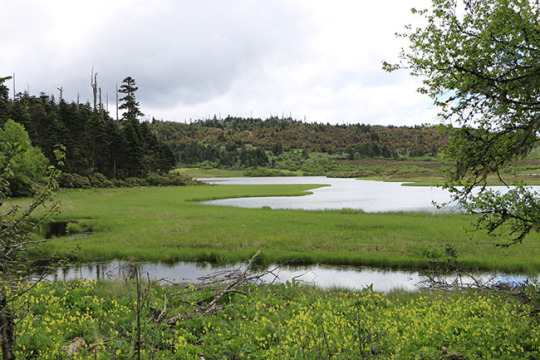
The massive colonies of P. sikkimensis extended around the lake.

Another colony-forming primrose is this pink beauty, if only we could grow it here in New Engand! Primula secundiflora is just another one of those Himalayan primroses which most of us could only dream of growing, yet here it grows in abundance, often forming large colonies near streams and wet bogs, deceiving us all with its weedy appearance. Don't taiunt us P. secundiflora!
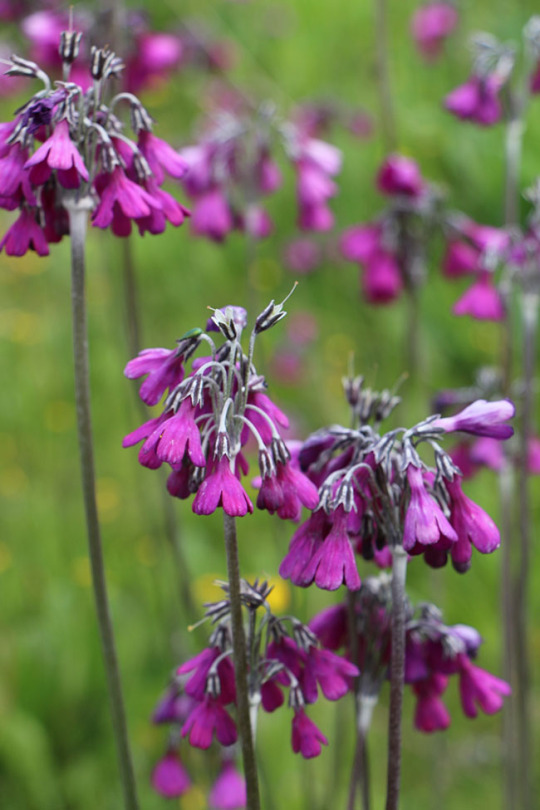
We came across colonies of P. secundiflora everywhere, but mostly between the areas around Zongdian (Shangrila) and Baimashan.

As you can see, some of the colonies were massive and every where one looked, there were thousands of plants.
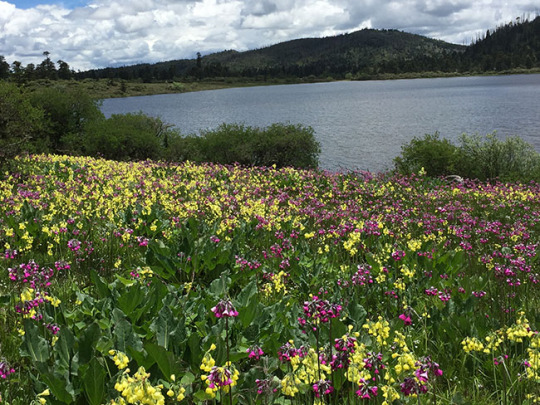
And then this happened. Primula overload once you mix it all together. So if you garden designers believe that yellow and magenta cant work together, don't tell Mother Nature. Both Primula secundiflora and P. sikkimensis growing on a wide seep at Tianchi Lake which is still at high elevation near 3800m. There were millions of them.
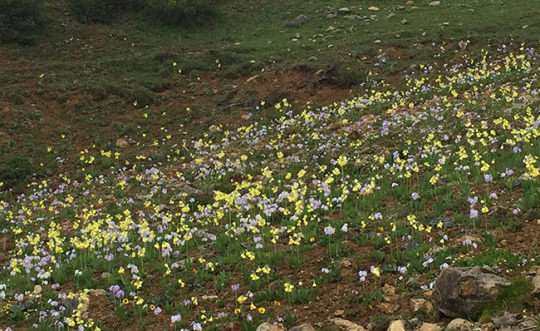
Other primroses colonize as well as if the above experiences weren't enough. Here are at least three species of primroses, maybe more. Most of the color in this meadow comes from the pale yellow P. sikkimensis and the pink P. zambalensis.
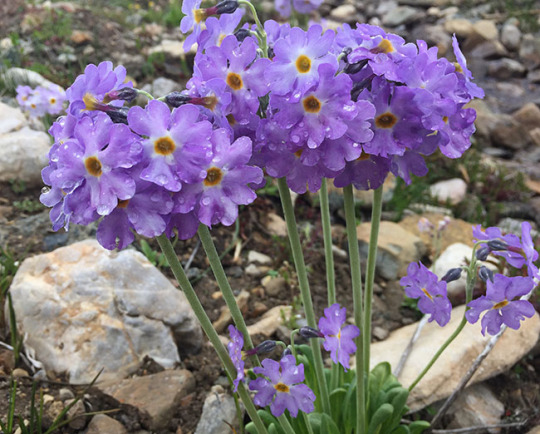
Colonies of P. zambalensis around Dechin and the high passes of Bai Ma Shan were quite variable, with some completely white and every shade of violet-pink inbetween.
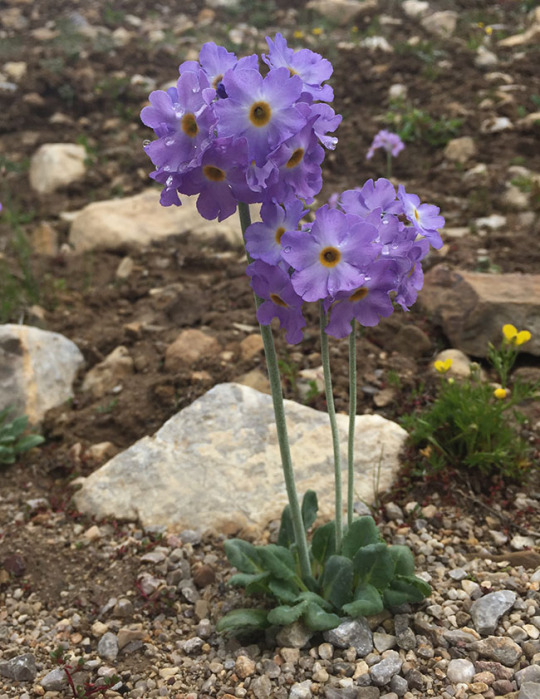
Every plant of this primula looks like a perfect pot plant.
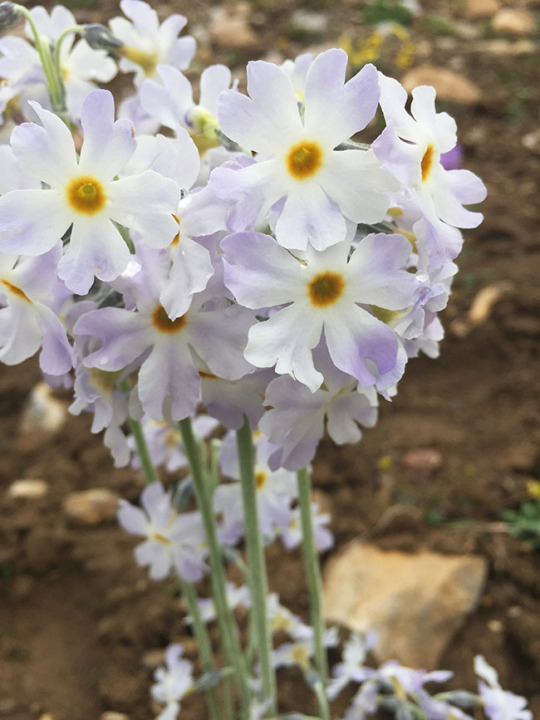
Here is one of the nearly white forms.

P.szechuanicawas the only species we saw in the section Maximowiczii which typically has species with dark or black flowers.

At lower elevations, if one can consider 11,000' low, we found primula in the woodlands. Here is P. polyneura on Baimashan.

P. polyneura with its wiry stems and delicate blooms in a woodland.

Scott Smith from Colorado treks across a high elevation pass loaded with tiny rhododendron in full bloom and even more primroses. The ten of us were starting to get tired on these last few days, but all it took was a single sighting of another rare plant to get us climbing high. This day we went the highest, up to 16,500'.
Throughout much of this area were other genus within primulaceae, so it makes sense to me to include a few from the genus Androsace, as they are so closely akin to primroses.

Androsace zambalensis (my guess). Please correct me.
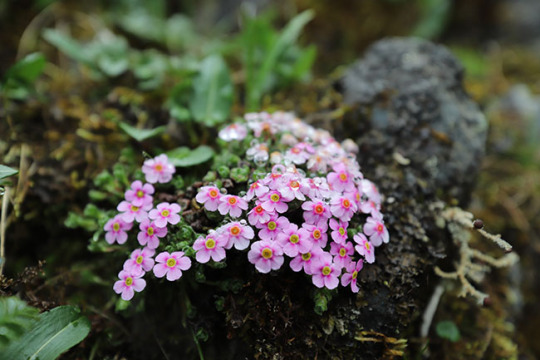
I probably shouldnt be covering Androsace, as I am not getting the names right, but I dont want this to hold up a post. This possibly is Androsace delavayi.

Many Androsace form rosettes or even tight buns at high elevation, but this one doesn't. Perhaps A. mariae.
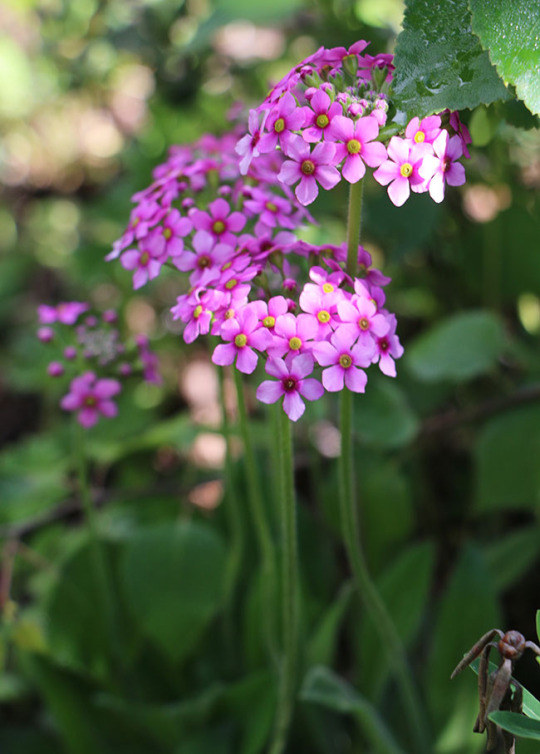
I think this is Androsace spinulifera
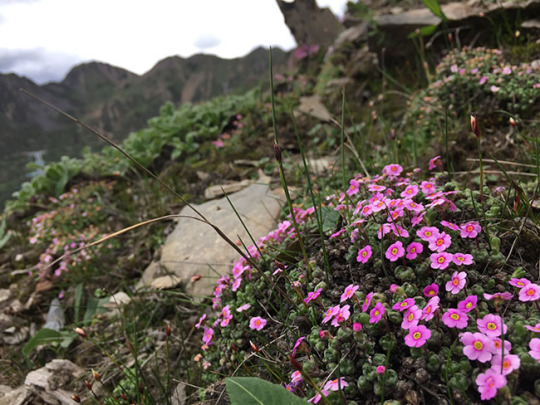
Androsace delavayi
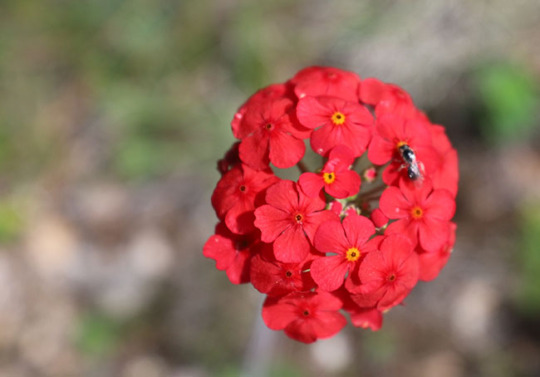
Perhaps the most lovely Androsace is this one we found on a knoll just above the Zhongdian plain, A. bulleyana.

Just above the road the encircles the great plain of Zhongdian in Shangrila were large colonies of this bright red Andnrosace. It forms tiny rosettes and long, wiry stems topped off with bright red umbels.

Androsace bulleyana in full sun growing in grass.

As you can see, primulaceae were found at all levels and in every location here in Northwestern Yunnan near the Tibetan borderlands. Truly a primrose-rich area and a sight few plant people ever get to see as most plant collectors collect in the autumn and not during the bloom season just after snowmelt in late spring and the Himalayan summer in June and early July.





0 notes
Text
The daze of rosés
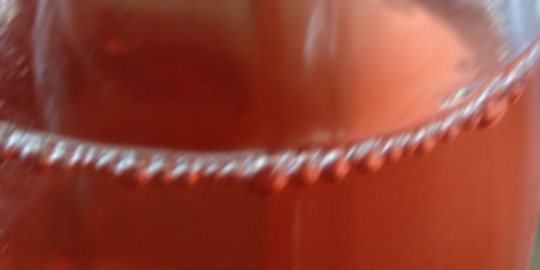
It's somewhere around the second half of July where Rosé season officially opens in Europe. When does it close? Well, that used to be the end of August when you could go visit Paris and even the homeless would be suckling a bottle of the pink stuff in the park. Nowadays, it seems the season never ends until the tap runs dry. And, as Rosé is a young wine that (really really shouldn't) see any oak aging, the tap is handily-refilled every harvest and thus, #roséallday is upon us.
As far as these things go, I mind it less than the Kardashians and more than cronut. The former is a vapid wasteland of a family that embodies all that is wrong with our culture while the latter is over-hyped but damned delicious. Rosé sits in the middle of this vast Kardashian/Cronut Divide as I can and do indeed enjoy it. I don't go out of my way to find it but if it's what's on the table and well made, I'll definitely indulge.
This is a long way to get into the fact that all wine writers are writing about Rosé at the moment and I might as well also. Such an article released in November is a lot like showing up to an ex's wedding; invitation or not it's just simply out of place.
I've recently been tasting about 200 wines from a single region in Spain that's primarily a red producer with a base of Grenache, Carignan, Syrah, and splashy hot potato of Tempranillo tossed in for kicks and giggles. Of the 200 labels I sampled, there were about 20 of them that were Rosés which is a rather shockingly-high proportion of 10% (whites were just a touch higher at 15% of the total). Of them, 25% where quite good, 50% were okay, and the remaining 25% were putrid. This is interesting to note as it's basically what I find to be the three styles of Rosé.
The Good
What makes a good Rosé these days? Liz Gabay MW wrote a whole book about the subject so she can clearly advise as to the finer details on the subject. For me, it's quite simply: character and clarity. It doesn't really matter if it's the darker Tavel or the lighter Provence style and in fact the Rosés I enjoyed ran the entire color spectrum which shows that it's not really as much of an indicator as one might think.
In these wines, there was a defined character and I could tell they were from a warmer growing climate in Spain but at the same time, they all held nuance. Picking was done thoughtfully and the idea was to make a Rosé wine from the start clearly. Deep, complex flavors were apparent and again, quite varied between them but they all spoke to me and lastly, they were all dry wines.
The Meh
Again, much like the good wines above, color and approach was quite scattered but the one aspect that bound all of them is that they were sweet. I don't have exact residual sugar (RS) counts from the winemakers but they seemed to range from a just-perceptible yet poorly-integrated 7g up to at least 15g. The sugar was sloppy, sticky, and did nothing to enhance the wines.
Why is Brut Champagne so popular? Because that 12g of sugar balances and smooths out the searing acidity in Champagne wonderfully. It's also why Brut Nature, essentially no sugar in Cava works so well as the acid is so much lower. Residual sugar in wine is like Jeff Goldblum in a movie: a little splash like Thor: Ragnorak is great, but a massive dose like Independence Day and it's going to wear on you. Balance is key with RS and in these middling Rosés, it was if the bosses were telling the winemakers, “We hear people like sweet shit. Make the Rosé sweet!” and thus, they were and thus, they had no depth, no character, impossible to perceive acidity, and no length.
These might be decent opinions if in the market for Yacht Rosé, but even that would be a stretch.
The Bad
And these wines were why Rosé was disliked for so long. Take some young vines or others grown in crappier locations and just toss whatever you have together. Smooth it out on the palate with maybe a bit of malolactic conversion or other treatments. Then, bind it by leaving a good deal of RS to cover up whatever else you couldn't hide.
These aren't wines that are crap because they're Rosé. They're crap because they're produced without attention and in a manner that's the polar opposite to the good batch. Garbage in, garbage out.
Given that I'm opening everything to taste with Coravin these days, I've put aside the good group. The bads had a date with my abused kitchen sink. As for the mehs, I've no idea. Maybe it's high time that I go shopping for a yacht to drink them on.
0 notes
Text
Rock stars at Kew: Alpine House rockery and dry garden
I've never been much into glasshouses. I generally find them jungly, warm, and humid - conditions I don't enjoy during Austin's long summers and don't wish to experience artificially. But an alpine glasshouse, with cool temps, tidy potted plants, and a nice breeze? Bring it on! While at Kew Gardens in London last month, I happily explored its Alpine House and surrounding rock garden, where chunky boulders make naturalistic raised beds and crevices for dry-garden plants from all over the world. I'd never seen a stone trough garden as massive as this one, which creates an alpine landscape in miniature with jagged slabs of thin stone placed on edge, like a mountain range, and small plants growing like miniature trees and shrubs at their base. The tall, white flowers throw off the effect a bit, but otherwise it's wonderful. More trough planters are arranged in a central plaza of the rock garden. A rock garden wouldn't be complete these days without a crevice garden. Again, I like the way the vertical slabs create the impression of a distant mountain range. The architecture of the Alpine House itself suggests the mountains. However, the design is about function first, as Kew's website […]
The post Rock stars at Kew: Alpine House rockery and dry garden appeared first on Digging.
0 notes
Text
Top 10 Tips on How to Store, Cellar and Age Wine
Wine is a living product which evolves with time. A number of rules must be followed in order to protect wine in an optimal manner, thus protecting and conserving its intrinsic aromatic and taste qualities. Following them will allow you to enjoy better wine, for longer. Here are 10 practical tips on where and how […]
The post Top 10 Tips on How to Store, Cellar and Age Wine was written by Julien Miquel and appeared first on Social Vignerons.
0 notes
Text
And that's Albariño, Pazo Señorans Colección 2014
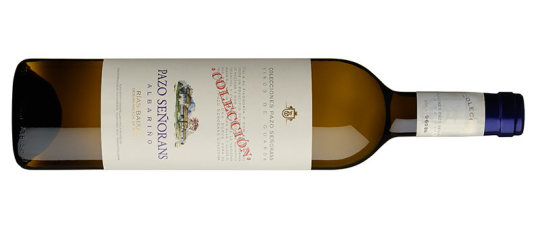
Albariño, and to a greater extent, DO Rías Baixas has been one of the many success stories in Spanish wine. I'd warrant that if hard pressed to name a Spanish white grape, the one that most people would think of (if any) would be Albariño–although it needs to be noted it's in Portugal as well under the similar name, Alvarinho.
It's become so established that it's a pretty standard white wine to pop up on blind tasting exams as it can have a profile similar to some northern French grapes with its peachy notes but it's that all-telling bitterness that always gives it away. That and in the best examples, there are saline notes given that Rías Baixas can have a good deal of Atlantic influence. Yeah yeah, I know, grapes don't pick up environmental factors in their flavors notes but yet… they do.
When looking for a “quintessential” example, Pazo Señorans is often tossed out as a possibility given they make a pretty classic, straight up version of the wine. That said, other producers have been experimenting with different takes on Albariño, entering into something of a “bored” period with the wines. It's not uncommon to find oaked examples or even others that have passed through malolactic conversion. If presented with one of these blind, you'd be right screwed as both these aging regimens made it difficult to ascertain the Albariño-ness that's so typical of the grape.
This example I received of the “Colección” is perfect in terms of what to expect from the grape. Fresh, crisp, great acidity, lively and not the least bit boring. My mother was visiting when I was tasting it and I think I make a new fan out of the grape as it's just so accessible in terms of profile but still offers up enough to keep interest. That said, this is a 2014 wine and I feel like it has peaked so if you come across it, I'd recommend tossing it in the fridge/ice bucket and opening it up for some fine living this summer of 2018.
Colección 2014
White peach, candied apricot, light raspberry hints, minor cut grass, wet straw. Fresh, crisp lemon, tart skin, high acidity, dried apricot in the finish, good persistence.
100% Albariño 13% 19€
**- 91
0 notes
Text
The Glera Grape behind Prosecco Wine in 1000 Words
Everything You Need to Know about the Glera Grape & Prosecco Wine… and more. Glera is the grape variety (the type of grapes) used to make the ultra-popular Prosecco sparkling wines. Glera is essentially the synonym of Veneto's Prosecco grape of northern Italy. The name by which it is now officially known. Top Interesting & […]
The post The Glera Grape behind Prosecco Wine in 1000 Words was written by Julien Miquel and appeared first on Social Vignerons.
0 notes
Text
How to Make Newspaper Seedling Pots
Newspaper seedling pots are useful, inexpensive little containers that can be easily made by cutting strips of newspaper and rolling them around a can, glass, or a fancy-dancy pot maker to make biodegradable starters for your seedlings. Make sure the paper you choose uses a non-toxic soy-based ink, especially when growing veggie starts. The vast ... Read More about How to Make Newspaper Seedling Pots
The post How to Make Newspaper Seedling Pots appeared first on Garden Therapy.
0 notes